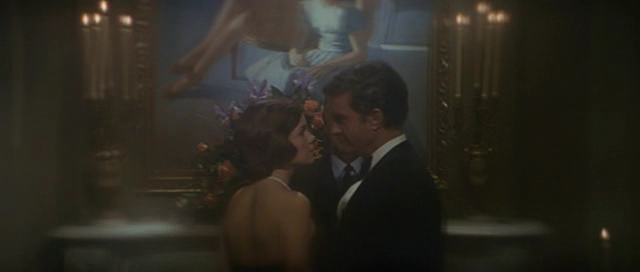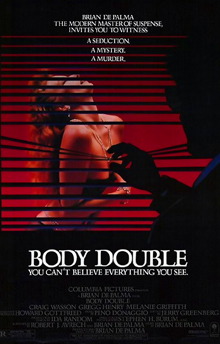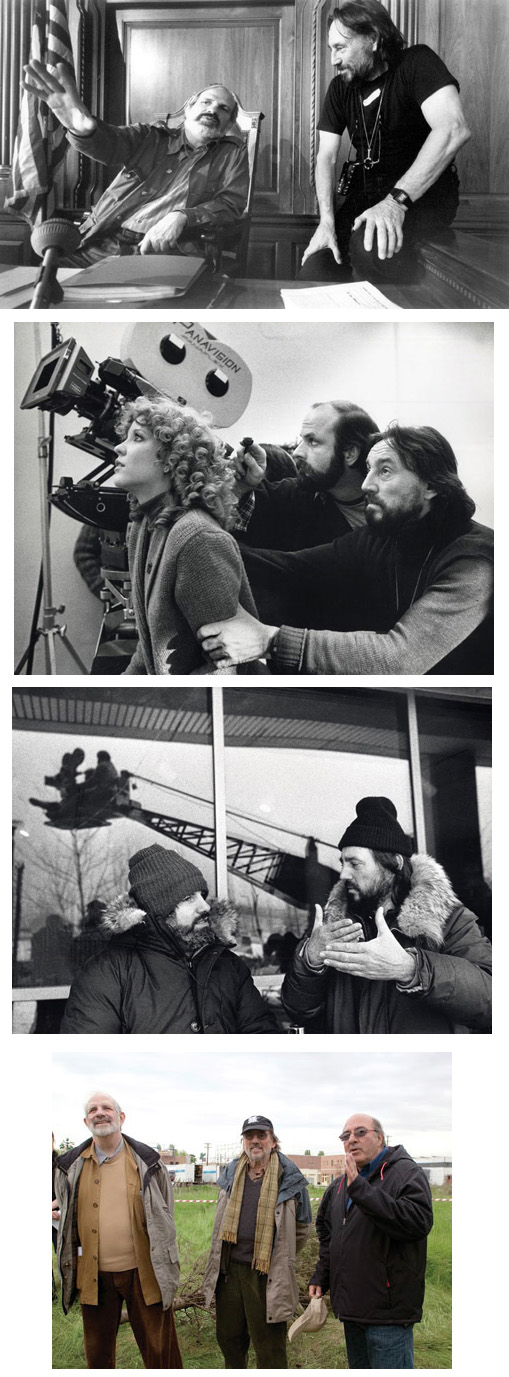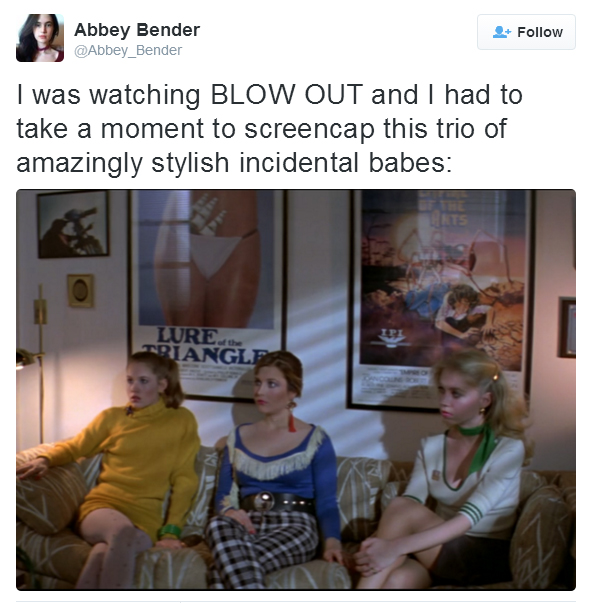Vilmos Zsigmond: Painter of Light from Brad Jones on Vimeo.
 Hello and welcome to the unofficial Brian De Palma website. Here is the latest news: |
|---|
E-mail
Geoffsongs@aol.com
-------------
Recent Headlines
a la Mod:
Listen to
Donaggio's full score
for Domino online
De Palma/Lehman
rapport at work
in Snakes
De Palma/Lehman
next novel is Terry
De Palma developing
Catch And Kill,
"a horror movie
based on real things
that have happened
in the news"
Supercut video
of De Palma's films
edited by Carl Rodrigue
Washington Post
review of Keesey book
-------------
Exclusive Passion
Interviews:
Brian De Palma
Karoline Herfurth
Leila Rozario
------------
------------
| « | January 2016 | » | ||||
| S | M | T | W | T | F | S |
| 1 | 2 | |||||
| 3 | 4 | 5 | 6 | 7 | 8 | 9 |
| 10 | 11 | 12 | 13 | 14 | 15 | 16 |
| 17 | 18 | 19 | 20 | 21 | 22 | 23 |
| 24 | 25 | 26 | 27 | 28 | 29 | 30 |
| 31 | ||||||
De Palma interviewed
in Paris 2002
De Palma discusses
The Black Dahlia 2006

Enthusiasms...
Alfred Hitchcock
The Master Of Suspense
Sergio Leone
and the Infield
Fly Rule
The Filmmaker Who
Came In From The Cold
Jim Emerson on
Greetings & Hi, Mom!
Scarface: Make Way
For The Bad Guy
Deborah Shelton
Official Web Site
Welcome to the
Offices of Death Records

But what about movies in which people are often indoors, talking? Zsigmond could put his subtle mark on those, too, as he did with the three films he shot for Woody Allen, Melinda and Melinda (2004), Cassandra’s Dream (2007), and You Will Meet a Tall Dark Stranger (2010). But among Zsigmond’s finest work are the four movies he did with [Brian] De Palma, Obsession (1976), Blow Out (1981), The Black Dahlia (2006) and The Bonfire of the Vanities (1990). Zsigmond had the technical skill to handle the elaborate tracking shots and split-screen effects so beloved by De Palma, but just as significantly, he could effectively key into the director’s particular brand of bleak romanticism and political mistrust. He gave Obsession—in which Cliff Robertson plays a man who becomes obsessed, Vertigo-style, with a woman who resembles his dead wife (Geneviève Bujold)—a look that balanced the coolness of old marble with the textured warmth of a peeling fresco, suitable for a love story wrapped in its own cozy little crypt. Zsigmond earned an Oscar nomination for his work on The Black Dahlia, a flawed picture whose visual magnificence is almost enough to hold it together. Zsigmond doesn’t just give the movie, set in the late 1940s, a period look; he lends it a burnished immediacy that unifies past and present, making whatever stereotypical sense we have of tawdry old Los Angeles seem as clichéd, and as wrong, as last year’s crushed hat.INDIEWIRE: REMEMBERING VILMOS ZSIGMOND IN 9 ESSENTIAL SHOTSZsigmond also left his signature, paradoxically both vivid and translucent, on one of the greatest of De Palma’s movies, Blow Out. John Travolta is a movie sound-effects guy who inadvertently captures audio evidence of an assassination when he witnesses a car driving off a bridge; Nancy Allen is the young woman he rescues (and falls for), a pawn in the plot. This is a quietly shimmering movie about disillusionment and doomed romance, and Zsigmond’s nighttime exteriors, both alluring and vaguely spooky, foreshadow despair rolling in like like fog.
Yet that thing we so casually think of as movie magic is really, when you boil it down, the even more magical summation of what happens when people know how to do their jobs. Zsigmond talked a little about Blow Out in in The Devil’s Candy, Julie Salamon’s superb study of the making of De Palma’s Bonfire of the Vanities: “There we were in the middle of the winter and there was this huge canyon and we were shooting a frog in the foreground and the river beyond and the trees and bridge above, and [De Palma] just walked up to it and said, ‘Light it. I don’t care how long it’s going to take. Light it.’ ” Zsigmond laughed in the story’s retelling. But also—damned if he didn’t light it.
Meanwhile, Indiewire's Zack Sharf posted nine essential shots by which to remember Zsigmond. Choosing the climactic shot of Jack holding the lifeless body of Sally as fireworks go off in the sky, Sharf writes, "Climaxes don't get more gorgeous than this one. As John Travolta's Jack Terry races through Philadelphia's Liberty Parade in order to save an escort (Nancy Allen) from the hands of an assassin, fireworks begin exploding in the sky as Zsigmond captures these blasts of color on their faces like bombs in a hectic war zone. Only when Terry holds Sally's lifeless body in his arms does the camera spin to reveal the actual display exploding in the sky —it's a moment of pure visual and emotional opera."
 The Brattle Theatre in Cambridge, MA, will screen a double-double feature Wednesday night (January 6th), with two screenings of Brian De Palma's Body Double (projected from DCP) at 4:30pm and 9:30pm. Sandwiched in between will be a single screening of Lawrence Kasdan's Body Heat, at 7pm (from a 35mm print). The screenings are part of the series, "Sex & Death & Venetian Blinds: Neo-Noir of the 1980s & 90s," which runs through January 14th.
The Brattle Theatre in Cambridge, MA, will screen a double-double feature Wednesday night (January 6th), with two screenings of Brian De Palma's Body Double (projected from DCP) at 4:30pm and 9:30pm. Sandwiched in between will be a single screening of Lawrence Kasdan's Body Heat, at 7pm (from a 35mm print). The screenings are part of the series, "Sex & Death & Venetian Blinds: Neo-Noir of the 1980s & 90s," which runs through January 14th."A CLEVERLY CONTRASTING DOUBLE BILL THAT BOTH VENERATES THE GENRE AND PUNKS IT"
The Artery's Sean Burns previews the double feature with fine insight:
Things kick off on Wednesday, Jan. 6, with the dynamic duo of “Body Heat” and “Body Double,” a cleverly contrasting double bill that both venerates the genre and punks it. A case can be made that “Body Heat,” screenwriter Lawrence Kasdan’s 1981 directorial debut, kick-started this entire noir revival, updating old-timey 1940s tropes for Ronald Reagan’s America by adding a healthy hunk of R-rated eroticism. Riffing on Billy Wilder’s “Double Indemnity,” Kasdan’s picture stars William Hurt as a dim-bulb, ambulance-chasing lawyer who finds himself head-over-heels and in way over his head with Kathleen Turner’s man-eating Matty Walker. “You aren’t too smart, are you?” she notes upon their first meeting, “I like that in a man.”Turner, then just 27, commands the screen with the brassy presence you’d expect from a Stanwyck or Bacall or any of the bygone icons in whose period fashions Kasdan has Matty rather anachronistically dressed (during the rare scenes when she’s wearing clothes). The hilarious Hurt has an awful mustache and the self-satisfied smirk of a man not nearly as clever as he thinks he is. She’s constantly touching him, keeping the schmuck in a slack-jawed state of arousal while he stumbles through her nefarious plan. Check out where Turner’s hands are just beneath the frame-line during a crucial scene and you can see she’s literally leading him around by the you-know-what.
Amusing as this may be, there’s something a bit studious about “Body Heat.” Kasdan’s ceiling fans and, yes, Venetian blinds often come across as film school affectations. Much of the film’s second half is the inelegant dispensing of information crucial to the plot. It’s rescued by loosey-goosey performances from the supporting cast, most famously a brief, star-making turn from Mickey Rourke as a gentle-hearted arsonist lip-syncing to Bob Seger. But watching the film again I was even more taken with Ted Danson’s ballroom-dancing prosecutor. His job is basically to stand next to Hurt and provide exposition, and yet the future Boston bartender is tirelessly toying with props and putting unexpected spins on unexciting lines. These original side characters break through Kasdan’s hermetic homages and references. They keep the movie from feeling too much like a museum.
You’ll see no such reverence in Brian De Palma’s “Body Double,” a spectacularly sleazy send-up that finds the puckish, thin-skinned director confronting his critics and, if you’ll forgive the term, doubling down on everything that upstanding, respectable people hate about Brian De Palma films. In his New York Times review, Vincent Canby described the director as “someone at an otherwise friendly dinner party who can’t keep himself from saying the one thing that will infuriate everybody. It’s as if he were daring the host to ask him back.”
Chafing at the then-widespread complaints that he was just a misogynistic Hitchcock knock-off obsessed with graphic violence and nudity, De Palma concocted this hilarious mash-up of “Rear Window” and “Vertigo” that just so happens to be chock full of graphic violence and nudity. Middle finger aloft, he cast the daughter (Melanie Griffith) of one of Hitch’s iconic blondes (Tippi Hedren) as a porn star and has the villain penetrating helpless women with a massive power drill held at crotch-level as the most unsubtle phallic symbol in the history of cinema.
If you can get on its perverse wavelength the film is screamingly funny — one of the more playful entries in De Palma’s filmography, boasting one of his rare happy endings. “Body Double” teases and explodes those old noir conventions that Kasdan and “Body Heat” hold so dear, simultaneously coating every sinuous camera movement with a slick sheen of totally ’80s gloss. The notorious centerpiece sequence is a dialogue-free porno movie shoot scored with Frankie Goes To Hollywood’s “Relax” that doesn’t look anything remotely like any porno movie ever made, but it’s a pretty good excuse for some cheeky virtuosity and dirty jokes.
As you might imagine, “Body Double” was not warmly embraced by audiences upon its theatrical release in 1984. (It opened the same day as “The Terminator” and was gone in three weeks.) But the film found a second life on late night cable, where Melanie Griffith became an object of considerable fascination for a generation of pubescent boys. Indeed, one of the nice chances afforded by the Brattle series is to finally see these films in an actual theater, instead of sneaking around the house watching with the volume turned down low after your parents or the babysitter have gone to sleep.

While his work with Spielberg and Cimino is his most acclaimed, Zsigmond’s greatest partner in crime was Brian De Palma, the most purely cinematic filmmaker of the last half-century, for whom the cinematographer did some of his finest, most innovative work. De Palma’s films are not governed by the rules or laws of reality; they adhere to a consistent, internal logic that favors excitement over emotion. Zsigmond extrapolated De Palma’s deep-rooted love for genre and exploitation, and helped the auteur construct his homage-laden films using the visual language written by earlier filmmakers. Together they were like a jazz duo drawing inspiration from their forebears, carving out of pulp scenes of brilliance and brutality. They employed an arsenal of in-camera tricks, from split-diopters to long Steadicam shots and meticulous use of zooms. Zsigmond shot Obsession [(’76)], a fervid Hitchcock homage, and Blow Out (’81), a contender for De Palma’s Best Film. For Blow Out, Zsigmond and De Palma deconstructed the art of filmmaking, reveling in the minutiae of filming and editing and spinning a story of paranoia and murder out of so many reels of celluloid.Zsigmond’s final masterpiece, and one of his most impressive achievements, is also one of De Palma’s most maligned films: The Black Dahlia (’06), which Zsigmond considered the last good film he worked on. A mostly faithful adaptation of James Ellroy's serpentine novel (it retains the terse dialogue while carefully uncoiling the notoriously difficult-to-follow plot), there's nary a shot here that doesn't get the De Palma touch: the camera looms and moves with purpose, zooming in, pulling out, hovering above a dead body splayed on a slab before slowly descending to a low-angle of our heroes framed against effervescent lights, or a crane shot showing the Zoot Suit riots sprawling across streets lined with burning cars and sprinkled with so much broken glass. The narrative is, admittedly, of minimal importance here, as is De Palma's and Zsigmond’s wont; the director fixates on the mood which his DP captured with stunning, sepia-steeped photography. If that isn’t a fine encapsulation of Zsigmond’s endearing legacy, then nothing is.
 Vilmos Zsigmond has passed away. He was 85. According to an initial report by Variety's Carmel Dagan, Zsigmond's business partner Yuri Neyman said that the legendary cinematographer died January 1st. Zsigmond shot four films for Brian De Palma over four decades: Obsession (1976), Blow Out (1981), The Bonfire Of The Vanities (1990), and The Black Dahlia (2006), the latter of which gained Zsigmond his fourth Oscar nomination (he won for his first nom, for Steven Spielberg's Close Encounters Of The Third Kind in 1977).
Vilmos Zsigmond has passed away. He was 85. According to an initial report by Variety's Carmel Dagan, Zsigmond's business partner Yuri Neyman said that the legendary cinematographer died January 1st. Zsigmond shot four films for Brian De Palma over four decades: Obsession (1976), Blow Out (1981), The Bonfire Of The Vanities (1990), and The Black Dahlia (2006), the latter of which gained Zsigmond his fourth Oscar nomination (he won for his first nom, for Steven Spielberg's Close Encounters Of The Third Kind in 1977).In 1992, Zsigmond directed the feature film The Long Shadow. In recent years, he made three films with Woody Allen, and also shot several episodes of NBC's The Mindy Project.
"IF YOU PLAY EVERYTHING IN CLOSE-UPS THEN YOU MIGHT AS WELL JUST READ THE BOOK"
In a 2014 interview with Filmmaker Magazine's Kaleem Aftab, Zsigmond was asked about when it is frustrating to work with a director. "If the director doesn’t like long shots and doesn’t like establishing shots and everything is based on words and dialogue and he wants to play everything up in close-up and use it that way, that’s no fun for me," replied Zsigmond. "I really think a movie should be visual, if the visuals are not good then I’m not interested. If you play everything in close-ups then you might as well just read the book. If you really want to have dialogue and just talk, talk, talk, there is no reason to go to the movie theater."
When asked what was the most difficult shot he had ever achieved, Zsigmond responded, "I don’t know what is the most difficult shot. But a difficult shot is to do something like at the start of Bonfire of the Vanities, the opening shot which is going on five minutes with a Steadicam, going from a basement, up an elevator, getting out of the elevator, going along the hallway until you end up a thousand feet away from where you started. That is all in one shot. If it works that’s great, it’s good for a film. The closer a film looks like reality and real life, the better it is." Asked how much planning went into that shot, Zsigmond said, "A whole day. One day of rehearsing and lighting and then the next night we were shooting at least ten times and one of them turned out good."
JAMES GUNN TRIBUTE: 'THE LONG GOODBYE' & 'BLOW OUT' ARE "TWO OF MY FAVORITE FILMS EVER"



On choosing Doyle for the award, artistic director of Film Fest Gent, Patrick Duynslaegher, had said, "This year’s focus of the 42nd Film Fest Gent will be on British Cinema, so Patrick Doyle was the ideal candidate to grant the Lifetime Achievement Award to, during the 15th World Soundtrack Awards. Anyone who can still recount hearing Doyle’s score for Kenneth Branagh’s debut film Henry V in 1989 for the first time, knows that back then a great composer was born. Ever since, Patrick Doyle has been a close collaborator with Mr. Branagh and always gave a deeper musical layer to all of his films including the Shakespeare adaptations (Henry V, Hamlet, Much Ado About Nothing, As You Like It and Love’s Labour’s Lost). The immensely versatile Doyle enriched the films by Robert Altman, Ang Lee, Chen Kaige, Alfonso Cuarón and Brian De Palma (one of his greatest scores was for Carlito’s Way) with his alternating tragic, noble, triumphant and romantic compositions. With his work on blockbusters such as Rise of the Planet of the Apes and Harry Potter and the Goblet of Fire he certainly proved his talent working on spectacular Hollywood action and adventure films."